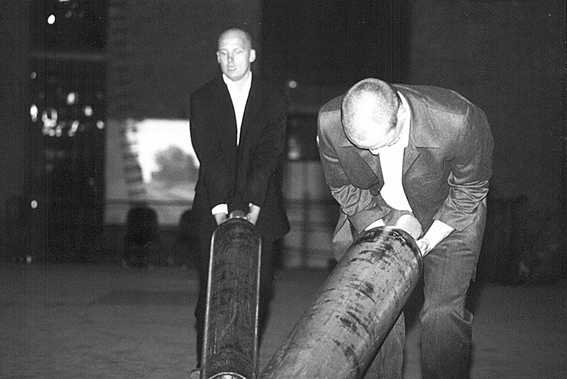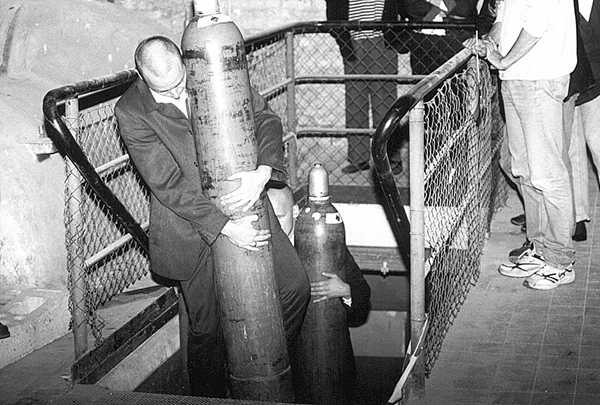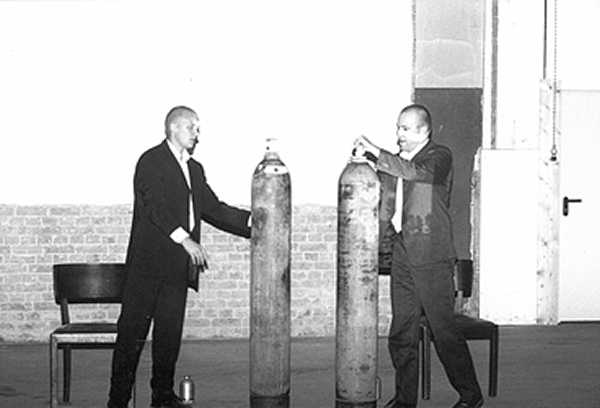concerto per il gas
A performance by SYSTEM HM2T in the „Gebläsehalle“ of the „Ilseder Hütte”, 28 June 2002.
Marco Teubner/Helge Meyer
System HM2T

1. Description
A large screen is put up at the front wall in a huge old factory building. Two simplistic wooden stools stand in front of the projection screen. The video recording on screen displays a scene of a quiet, idyllic landscape: A path, located on the edge of a forest, a single tree and, in the background, a hill lined with an avenue of trees can be seen, accompanied by the sounds of birds chirping softly.
The birds' singing is accompanied by a metallic, grinding sound coming from a different part of the old building. In the basement, two men - dressed in black suits - drag along two huge metallic bottles. They are dragging them all across the building to a metal staircase at the other end of the building. Taking turns, they heave the bottles step by step up the staircase. The echo of the bottles hitting the metal steps resonates in a steady dull pounding sound. Having reached the top of the staircase, the two men drag the bottles across the hall again, to the two chairs in front of the screen. After removing the caps of the bottles, they sit down on the chairs and place the bottles between their legs like huge heavy musical instruments. When the two men open the valves of the oxygen cylinders, the gas escapes with an unbearable noise. While the gas escapes with a bluish stream, the two men sit motionless in their chairs. Both men look tired from the physical strain of their work, breathing heavily. The body is longing for the released gas – the supply lack has to be regained.
Behind them, the idyllic landscape is still visible on the screen. Now, two men dressed in black walk along the path located on the edge of the forest. Both carry a heavy blue gas cylinder. The closer they get, the more evident is their exhausting effort to carry these cylinders. Constantly accompanied by the hissing sound of the streaming gas, which drowns out the chirping of the birds, the sonority of the sound fills out the old factory building. When the two men on the screen have disappeared, and the peaceful and quiet picture from the beginning is restored on the screen again, the gas cylinders are almost empty and the fierce sound of the streaming gas slowly vanishes until it finally ends. Through the now restored soothing silence, the quiet, soft chirping of the birds can be heard again. Both men put down their bottles, which are covered with a layer of ice from the streaming gas, and leave the place. On the screen in the background the larger-than-life shadows of the bottles are visible and they are blending into the landscape motif.

2. Thoughts
With our more recent work we have always applied the method of doubling by the means of video projection. Our watching habits, which are determined by the media, and the mixing of film sequences and live performance lead to interesting structures. Apparently, the displayed video picture on the screen can be easily combined with the actual actions of the performance and blend into a story. Behind this, the scrutinizing of the basic structures of a performance is of utmost importance as well as the questions about the preservation, the storage of the performing act. After all, it is an artistic statement about the insubstantial condition, the non-material existence of the performance as an art form.

The performance can only be present, it can only take place. Is the performance consequently a piece of art, which blooms in the present tense, in complete authenticity? And, in this form, can it actually be categorised as fine arts at all, if the creative aspect of durabillity is thus missing? It is not only these unanswered questions that lead to a misinterpretation and false classification of the performance concept? Even creative artists are trying to escape from the immaterial aspects of art in various ways. The shadow play of our performance, depicted on the video screen (in this case the shadows of the gas cylinders being projected into the landscape, accordingly) should be a reflection of these questions.
In addition, our artistic work is marked by highly exhausting physical strains. "Strain" is not meant in the sense of doing work here, it is rather like acting out the physical nature of a body. Strenuous efforts and states of exhaustion lead to an increased body consciousness and a more differentiated expressiveness. It is our intention to combine the physically dominated, strong actions with the diametrically quiet, picturesque moments, to present the body as the immanent and essential part of a performance in a conflicting area of an aesthetic screen-production. Performance is thus a triad of image, body and action.
